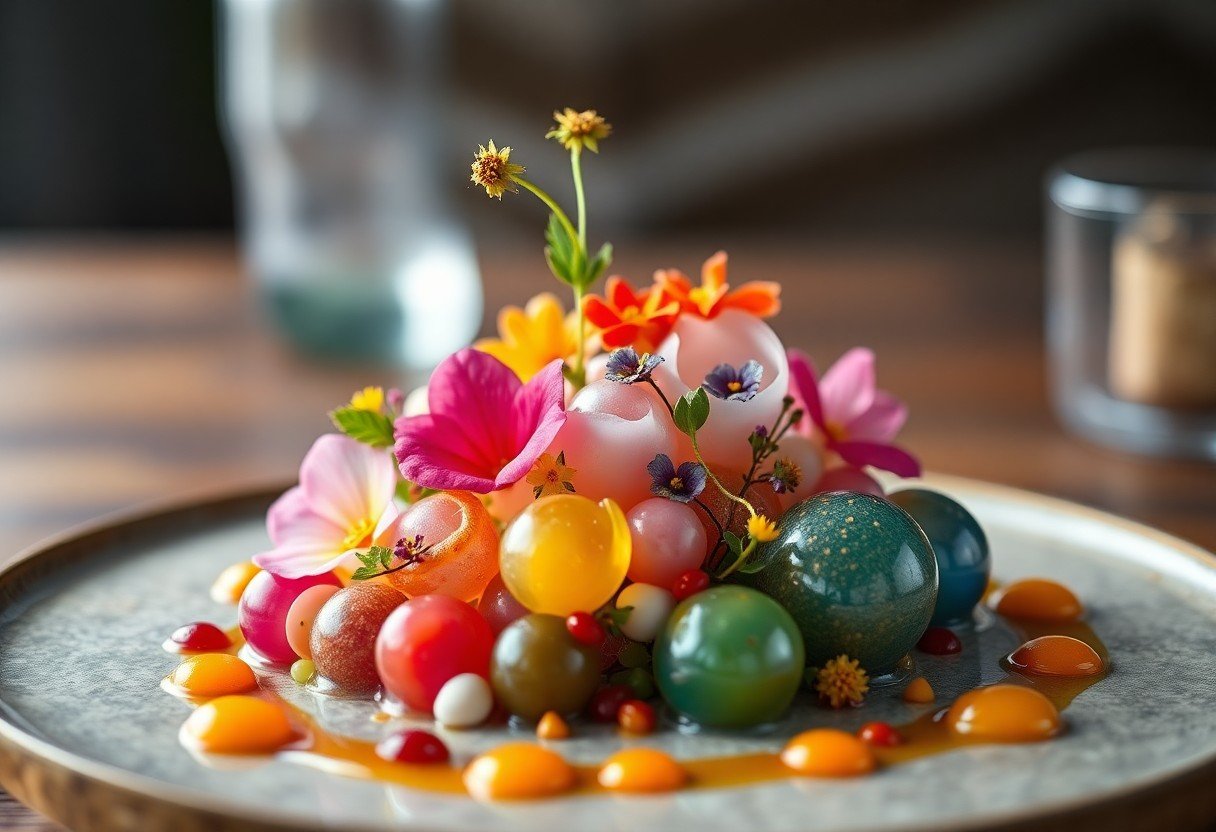There’s a fascinating world waiting for you in avant-garde food creations, where culinary boundaries are pushed and your senses are challenged. From unexpected flavor combinations to innovative techniques, these dishes not only serve as a meal but also as an art form that can captivate and astound. You’ll discover how science and creativity intertwine to create dining experiences that provoke thought and evoke emotion. Join us as we unveil the secrets behind these remarkable gastronomic adventures and explore how they can transform your perception of food.

The Evolution of Avant-Garde Cuisine
While the culinary world has always embraced innovation, the evolution of avant-garde cuisine marks a significant departure from traditional cooking approaches. You find this style characterized by bold experiments with flavors, textures, and presentation, as well as the embracing of scientific techniques and unexpected ingredient pairings. This movement reflects a constant quest for originality that pushes gastronomic boundaries, enticing your taste buds into uncharted territories.
Historical Influences
Above all, the roots of avant-garde cuisine reveal a tapestry of influences ranging from molecular gastronomy to the art movements of the 20th century. You can trace its origins back to chefs who broke away from conventional methodologies, challenging the norms and seeking inspiration from diverse sources including literature, art, and science.
Key Pioneers and Movements
For anyone interested in avant-garde cuisine, understanding the key pioneers and movements is crucial to grasp its evolution. Notable chefs such as Ferran Adrià and Heston Blumenthal have played pivotal roles in this culinary revolution, introducing techniques like spherification and sous-vide cooking. Their work exemplifies innovation that goes beyond taste, transforming the dining experience into a multisensory journey.
Cuisine continually evolves, with groundbreaking chefs advocating for the melding of artistry and science. You observe that the avant-garde food movement includes key figures like Grant Achatz and Wylie Dufresne, who push the envelope using techniques that surprise and engage the diner. Philosophies such as locavore and foraging also shape the movement, emphasizing a connection with nature. Each step in this evolution demonstrates the inherent desire for creativity and innovation, challenging your palate while redefining the essence of fine dining.

Techniques and Technologies in Avant-Garde Cooking
One of the most fascinating aspects of avant-garde cooking is the innovative techniques and technologies that chefs employ to elevate their culinary creations. These methods blend scientific principles with artistic expression, transforming the dining experience into something truly extraordinary. By utilizing cutting-edge tools and processes, you can push the boundaries of flavor, texture, and presentation, leading to an unforgettable gastronomic adventure.
Molecular Gastronomy
At the forefront of avant-garde cooking is molecular gastronomy, which combines food science with culinary art. This innovative technique focuses on understanding the physical and chemical transformations that occur during cooking. Through processes like spherification, gelification, and emulsification, you can create uniquely textured dishes that surprise and delight the palate, offering a sensory experience that challenges traditional culinary norms.
Innovative Cooking Methods
With the evolution of cooking technologies, innovative methods such as sous vide, foam generation, and cryogenic techniques have gained popularity in avant-garde kitchens. These avant-garde tools allow you to achieve precise temperature control and create unique textures and flavors that were once thought impossible. From vacuum-sealed bags to culinary blowtorches, the use of advanced equipment in your cooking allows for endless experimentation and creativity.
Considering the rise of innovative cooking methods, such as sous vide and cryogenic freezing, you can explore exciting possibilities in your kitchen. These techniques not only enhance the presentation of your dishes but also enable you to achieve precise and consistent results. For instance, sous vide allows you to cook food at controlled temperatures, ensuring that proteins remain tender and juicy. However, it’s important to approach these methods safely, as working with substances like liquid nitrogen can be dangerous if not handled properly. Ultimately, these avant-garde techniques can transform your culinary repertoire, elevating familiar ingredients into extraordinary dining experiences that will amaze your guests.

Ingredients Transforming Modern Palates
Keep an open mind as you explore the world of avant-garde cuisine, where traditional boundaries of taste and texture are continuously being challenged. Ingredients that were once deemed unconventional are now reshaping modern palates, inviting you to experience dishes that tantalize your senses in unexpected ways. From molecular gastronomy to foraged botanicals, you’ll discover how these innovative approaches can elevate your culinary adventures.
Unusual Flavor Pairings
Beside the classic combinations, the avant-garde culinary scene introduces unexpected flavor pairings that will surprise and delight you. Unexpected alliances, such as chocolate with olive oil or smoked fish with fruit, encourage you to rethink your taste preferences and embrace the art of contrast. You’ll find that these pairings not only challenge your palate but also spark your creativity in the kitchen.
The Role of Sustainability
To truly appreciate avant-garde cuisine, it’s vital to understand the role of sustainability in ingredient selection. You will find that many chefs are committed to sourcing local and seasonal produce, using practices that minimize environmental impact. By supporting sustainable farming and wild foraging, you not only indulge in exquisite flavors but also contribute to the well-being of our planet.
Also, sustainability enhances your dining experience by fostering a deeper connection to your food sources. Chefs often emphasize ethical practices and prioritize organic ingredients, resulting in meals that are not only delicious but also representative of the earth’s bounty. This commitment ensures that your culinary experiences are higher quality and made from fresh, vibrant components. As you savor these dishes, you can feel proud knowing you’re making choices that support environmental health and sustainability.
The Aesthetic Experience of Avant-Garde Food
Once again, the world of avant-garde food transcends the mere act of eating, placing you in an immersive experience that tantalizes all your senses. This culinary movement transforms the plate into a canvas, beckoning you to explore not just flavors but the artistic narrative behind each dish. Your encounter with these creations is a journey, inviting you to appreciate the beauty and innovation that lie within each bite.
Presentation as an Art Form
Before you investigate the meal, take a moment to appreciate how presentation elevates food to a form of artistic expression. Every element, from the colors to the plating technique, contributes to your overall experience. The effort that chefs pour into crafting their visuals often speaks volumes about their creativity and intention, urging you to engage with the meal on a deeper level.
The Impact of Visuals on Taste Perception
Across your dining experience, the visuals play an important role in shaping your perception of taste. Your eyes lead the way, guiding your expectations and influencing how you respond to the flavors presented before you. The interplay of aesthetics and taste can make a dish more appealing or even change your sensory response altogether, setting the stage for a memorable culinary adventure.
Also, it’s fascinating how your brain equates the visual presentation of food with flavor quality. Studies show that your perception of taste can significantly shift based on the arrangement and colors of the food in front of you. A dish that is beautifully plated is more likely to elicit intense flavors, making the experience enjoyable. You might even find yourself rating a dish more favorably simply because its presentation aligns with your expectations, emphasizing just how powerful the visuals can be in enhancing your overall gastronomic enjoyment.
The Cultural Implications of Avant-Garde Food
Despite its experimental nature, avant-garde food serves as a powerful reflection of cultural identity and social dynamics. By pushing culinary boundaries, chefs invite you to explore hidden narratives and challenge traditional values. If you want a deeper understanding of these concepts, check out Imagine – by Avant Garde for inspiration.
Global Fusion and Identity
An exciting verse in avant-garde cuisine is its ability to blend various culinary traditions from around the world. This global fusion often highlights commonalities between cultures, allowing you to appreciate diverse ingredients and cooking techniques that shape your palate and identity.
Food as a Medium for Social Commentary
Avant-garde food transcends mere sustenance, functioning as a profound medium for social commentary. It gives you the power to question societal norms and provoke thought through uniquely crafted dishes that carry a message. Chefs often employ surprising presentations and unexpected flavor combinations to communicate pressing issues, such as food waste, inequality, and environmental concerns. This emergent trend in culinary arts not only nourishes your body but also ignites conversation about the socio-political climate, prompting you to consider your impact on the world.
Challenges and Critiques Facing Avant-Garde Cuisine
Not everyone appreciates the bold and unconventional nature of avant-garde cuisine. Critics often argue that these innovative dishes can overshadow the fundamental joys of food, focusing too heavily on presentation or technique rather than taste. Additionally, the complexity and often high cost can deter potential diners, leading you to question whether the experience can truly satisfy your culinary desires.
Accessibility and Inclusivity
Any culinary movement should strive to be accessible to all food enthusiasts. Unfortunately, avant-garde cuisine tends to be limited by upscale dining environments and extravagant presentations that create barriers for many. This exclusivity can alienate those who want to explore creative dishes but might feel intimidated by the high prices or complex concepts behind the food.
Ethical Considerations
Behind the allure of avant-garde cuisine, there are often ethical dilemmas regarding sourcing and sustainability. The use of exotic ingredients and experimental techniques may lead you to question the environmental impact of such choices. It’s important to consider whether the drive for innovation justifies potential harm to communities and ecosystems.
Accessibility to avant-garde cuisine is challenged by its reliance on often exotic ingredients and complex techniques that may not align with sustainable practices. You should be aware that sourcing these unique elements can lead to over-exploitation of natural resources and adversely affect local communities. When indulging in avant-garde dining, it’s vital to reflect on whether the pursuit of novelty comes at the expense of our ethical responsibilities to the planet and its inhabitants.
Final Words
Summing up, as you explore avant-garde food creations, you uncover a world rich in innovation and sensory experience. Each dish is a testament to creativity, pushing the boundaries of flavor, presentation, and technique. By embracing the unexpected combinations and artistic expressions found in this culinary landscape, you not only expand your palate but also gain insight into the future of gastronomy. Engaging with avant-garde cuisine allows you to appreciate the artistry behind every bite, transforming your dining experience into something truly extraordinary.









